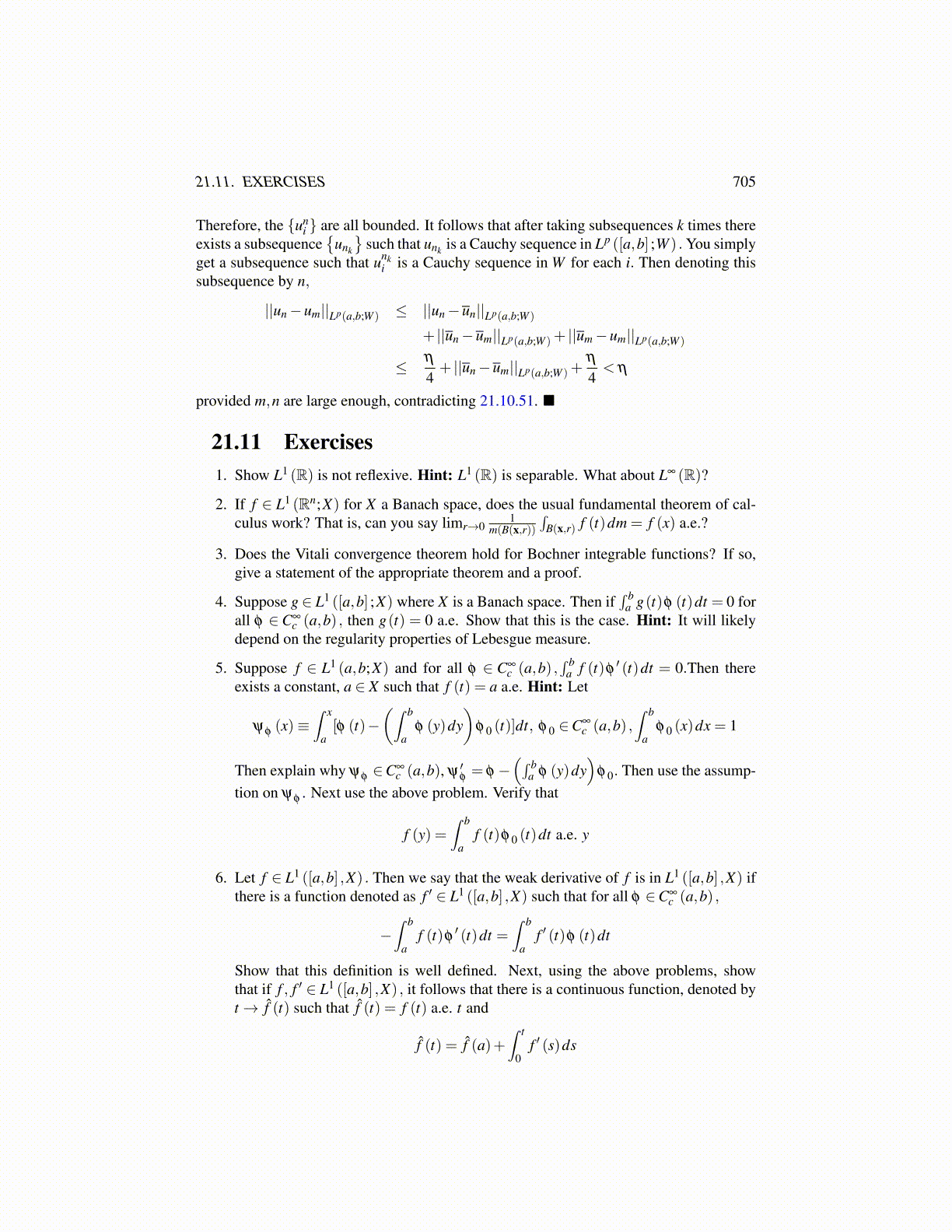
21.11. EXERCISES 705
Therefore, the {uni } are all bounded. It follows that after taking subsequences k times there
exists a subsequence{
unk
}such that unk is a Cauchy sequence in Lp ([a,b] ;W ) . You simply
get a subsequence such that unki is a Cauchy sequence in W for each i. Then denoting this
subsequence by n,
||un−um||Lp(a,b;W ) ≤ ||un−un||Lp(a,b;W )
+ ||un−um||Lp(a,b;W )+ ||um−um||Lp(a,b;W )
≤ η
4+ ||un−um||Lp(a,b;W )+
η
4< η
provided m,n are large enough, contradicting 21.10.51.
21.11 Exercises1. Show L1 (R) is not reflexive. Hint: L1 (R) is separable. What about L∞ (R)?
2. If f ∈ L1 (Rn;X) for X a Banach space, does the usual fundamental theorem of cal-culus work? That is, can you say limr→0
1m(B(x,r))
∫B(x,r) f (t)dm = f (x) a.e.?
3. Does the Vitali convergence theorem hold for Bochner integrable functions? If so,give a statement of the appropriate theorem and a proof.
4. Suppose g ∈ L1 ([a,b] ;X) where X is a Banach space. Then if∫ b
a g(t)φ (t)dt = 0 forall φ ∈C∞
c (a,b) , then g(t) = 0 a.e. Show that this is the case. Hint: It will likelydepend on the regularity properties of Lebesgue measure.
5. Suppose f ∈ L1 (a,b;X) and for all φ ∈ C∞c (a,b) ,
∫ ba f (t)φ
′ (t)dt = 0.Then thereexists a constant, a ∈ X such that f (t) = a a.e. Hint: Let
ψφ (x)≡∫ x
a[φ (t)−
(∫ b
aφ (y)dy
)φ 0 (t)]dt, φ 0 ∈C∞
c (a,b) ,∫ b
aφ 0 (x)dx = 1
Then explain why ψφ ∈C∞c (a,b), ψ ′
φ= φ −
(∫ ba φ (y)dy
)φ 0. Then use the assump-
tion on ψφ . Next use the above problem. Verify that
f (y) =∫ b
af (t)φ 0 (t)dt a.e. y
6. Let f ∈ L1 ([a,b] ,X) . Then we say that the weak derivative of f is in L1 ([a,b] ,X) ifthere is a function denoted as f ′ ∈ L1 ([a,b] ,X) such that for all φ ∈C∞
c (a,b) ,
−∫ b
af (t)φ
′ (t)dt =∫ b
af ′ (t)φ (t)dt
Show that this definition is well defined. Next, using the above problems, showthat if f , f ′ ∈ L1 ([a,b] ,X) , it follows that there is a continuous function, denoted byt→ f̂ (t) such that f̂ (t) = f (t) a.e. t and
f̂ (t) = f̂ (a)+∫ t
0f ′ (s)ds